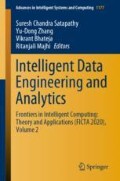Abstract
Newly, varied techniques are implemented to improve and mine the apprehensive segment from the brain MRI obtained with diverse modalities. This work executes an image-fusion practice to combine the MRIs of dissimilar modalities, to improve the correctness in the assessment task. A Principle-Component-Analysis (PCA) supported fusion is employed to enhance tumor of brain MRI. This work considers the 2D slices of BRATS-2015 image for the assessment. Later, the segmentation based on Chan-Vese is executed and its performance is evaluated against DRLS. A comparative investigation among tumor section and ground-truth (GT) is implemented and vital picture-likeliness constraints are computed. The result of this work is compared against DWT-PCA procedure accessible in literature, and the experimental results of this technique offered better results, which substantiate the superiority of PCA practice.
Access this chapter
Tax calculation will be finalised at checkout
Purchases are for personal use only
References
Bhateja, V., Nigam, M., Bhadauria, A.S., Arya, A., Yu-Dong Zhang, Y-D.: Human visual system based optimized mathematical morphology approach for enhancement of brain MR images. J. Ambient. Intell. Humaniz. Comput. 1–9 (2019). https://doi.org/10.1007/s12652-019
Menze, B., Reyes, M., Leemput, K.V., et al.: The multimodal brain tumor image segmentation benchmark (BRATS). IEEE Trans. Med. Imaging 34(10), 1993–2024 (2015)
Rajinikanth, V., Satapathy, S.C., Fernandes, S.L., Nachiappan, S.: Entropy based segmentation of tumor from brain MR images—a study with teaching learning based optimization. Pattern Recognit. Lett. 94, 87–94 (2016). https://doi.org/10.1016/j.patrec.2017.05.028
Fernandes, S.L., et al.: A reliable framework for accurate brain image examination and treatment planning based on early diagnosis support for clinicians. Neural Comput. Appl. 1–12 (2019). https://doi.org/10.1007/s00521-019-04369-5
Dey, N., et al.: Social-Group-Optimization based tumor evaluation tool for clinical brain MRI of flair/diffusion-weighted modality. Biocybern. Biomed. Eng. 39(3), 843–856 (2019). https://doi.org/10.1016/j.bbe.2019.07.005
Jahmunah, V., et al.: Automated detection of schizophrenia using nonlinear signal processing methods. Artif. Int. Med. 100, 101698 (2019). https://doi.org/10.1016/j.artmed.2019.07.006
Rajinikanth, V., Fernandes, S.L., Bhushan, B., Sunder, N.R.: Segmentation and analysis of brain tumor using Tsallis entropy and regularised level set. Lecture Notes in Electrical Engineering, vol. 434, pp. 313–321 (2018)
Rajinikanth, V., Dey, N., Satapathy, S.C., Ashour, A.S.: An approach to examine magnetic resonance angiography based on Tsallis entropy and deformable snake model. Futur. Gener. Comput. Syst. 85, 160–172 (2018). https://doi.org/10.1016/j.future.2018.03.025
Raja, N.S.M., Fernandes, S.L. Dey, N., Satapathy, S.C., Rajinikanth, V.: Contrast enhanced medical MRI evaluation using Tsallis entropy and region growing segmentation. J. Ambient. Intell. Humaniz. Comput. 1–12 (2018). https://doi.org/10.1007/s12652-018-0854-8
Rajinikanth, V., Satapathy, S.C., Dey, N., Vijayarajan, R.: DWT-PCA image fusion technique to improve segmentation accuracy in brain tumor analysis. LNEE 471, 453–462 (2018). https://doi.org/10.1007/978-981-10-7329-8_46
Farahani, K., Menze, B., Reyes, M.: Multimodal Brain Tumor Segmentation (BRATS 2013) (2013). http://martinos.org/qtim/miccai2013/
Vijayarajan, R., Muttan, S.: Local principal component averaging image fusion, Int. J. Imaging Robot. 13(2), 94–103 (2014)
Vijayarajan, R., Muttan, S.: Fuzzy C-means clustering based principal component averaging fusion. Int. J. Fuzzy Syst. 16(2), 153–159 (2014)
Vijayarajan, R., Muttan, S.: Iterative block level principal component averaging medical image fusion. Optik-Int. J. Light Electron Opt. 125(17), 4751–4757 (2014)
Srivastava, A., Bhateja, V., Moin, A.: Combination of PCA and contourlets for multispectral image fusion. Adv. Intell. Syst. Comput. 469, 577–585 (2017). https://doi.org/10.1007/978-981-10-1678-3_55
Chan, T.F., Vese, L.A.: Active contours without edges. IEEE Trans. Image Process 10(2), 266–277 (2001)
Rajinikanth, V., Dey, N., Kumar, R., Panneerselvam, J., Raja, N.S.M.: Fetal head periphery extraction from ultrasound image using Jaya algorithm and Chan-Vese segmentation. Procedia Comput. Sci. 152, 66–73 (2019). https://doi.org/10.1016/j.procs.2019.05.028
Manic, K.S., et al.: An approach to examine brain tumor based on Kapur’s entropy and Chan-Vese algorithm. AISC 797, 901–909 (2019). https://doi.org/10.1007/978-981-13-1165-9_81
Kowsalya, N., et al.: Skin-melanoma evaluation with Tsallis’s thresholding and Chan-Vese approach. In. IEEE International Conference on System, Computation, Automation and Networking (ICSCA), pp.1–5. IEEE (2018). https://doi.org/10.1109/ICSCAN.2018.8541178
Rajinikanth, V., Satapathy, S.C.: Segmentation of ischemic stroke lesion in brain MRI based on social group optimization and Fuzzy-Tsallis entropy. Arab. J. Sci. Eng. 43(8), 4365–4378 (2018). https://doi.org/10.1007/s13369-017-3053-6
Satapathy, S.C., Rajinikanth, V.: Jaya algorithm guided procedure to segment tumor from brain MRI. J. Optim. 2018, 12 (2018). https://doi.org/10.1155/2018/3738049
Fernandes, S.L., Rajinikanth, V., Kadry, S.: A hybrid framework to evaluate breast abnormality using infrared thermal images. IEEE Consum. Electron. Mag. 8(5), 31–36 (2019). https://doi.org/10.1109/MCE.2019.2923926
Bhandary, A., et al.: Deep-learning framework to detect lung abnormality–a study with chest X-ray and lung CT scan images. Pattern Recogn. Lett. (2019). https://doi.org/10.1016/j.patrec.2019.11.013
Author information
Authors and Affiliations
Corresponding author
Editor information
Editors and Affiliations
Rights and permissions
Copyright information
© 2021 The Editor(s) (if applicable) and The Author(s), under exclusive license to Springer Nature Singapore Pte Ltd.
About this paper
Cite this paper
Abirami, D., Shalini, N., Rajinikanth, V., Lin, H., Rao, V.S. (2021). Brain MRI Examination with Varied Modality Fusion and Chan-Vese Segmentation. In: Satapathy, S., Zhang, YD., Bhateja, V., Majhi, R. (eds) Intelligent Data Engineering and Analytics. Advances in Intelligent Systems and Computing, vol 1177. Springer, Singapore. https://doi.org/10.1007/978-981-15-5679-1_65
Download citation
DOI: https://doi.org/10.1007/978-981-15-5679-1_65
Published:
Publisher Name: Springer, Singapore
Print ISBN: 978-981-15-5678-4
Online ISBN: 978-981-15-5679-1
eBook Packages: Intelligent Technologies and RoboticsIntelligent Technologies and Robotics (R0)

